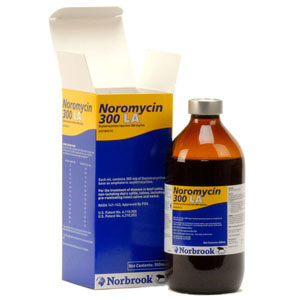Meganyl 50 mg/ml
MEGANYL 50 mg/ml Solution for Injection for cattle, pigs and horses is a veterinary antibiotic injection containing florfenicol as the active ingredient. This broad-spectrum antibiotic belongs to the phenicol class of antimicrobial agents specifically formulated for large animal veterinary use.
Active Ingredient and Classification
Primary Component:
Florfenicol 50 mg/ml – A synthetic broad-spectrum antibiotic
Drug Class: Phenicol antibiotic
Mechanism: Florfenicol is a bacteriostatic antibiotic that is primarily used in veterinary medicine to treat a range of diseases in farm and aquatic animals. This synthetic analog of thiamphenicol and chloramphenicol works by inhibiting ribosomal activity
Target Species and Indications
Approved Species:
Cattle (beef and dairy)
Pigs (swine)
Horses (equine)
Primary Therapeutic Uses:
Bovine Respiratory Disease (BRD):
Florfenicol has been shown to be effective for treatment of bovine respiratory disease (BRD) in cattle associated with Mannheimia haemolytica, Pasteurella multocida, and Histophilus somni (formerly Haemophilus somnus)
For treatment of bovine respiratory disease associated with Mannheimia haemolytica, Pasteurella multocida, and Histophilus somni, and for the treatment of bovine interdigital phlegmon
Additional Indications:
Foot rot treatment: It also is used for treatment of bovine interdigital phlegmon (foot rot, acute interdigital necrobacillosis, and infectious pododermatitis) associated with Fusobacterium necrophorum and Bacteroides melaninogenicus
Various bacterial infections caused by susceptible organisms
Pharmacological Properties
Mechanism of Action:
This synthetic analog of thiamphenicol and chloramphenicol works by inhibiting ribosomal activity, thereby preventing bacterial protein synthesis, resulting in bacteriostatic effects against susceptible bacteria.
Spectrum of Activity:
Gram-positive bacteria: Including Staphylococcus and Streptococcus species
Gram-negative bacteria: Including Pasteurella, Mannheimia, and Histophilus species
Anaerobic bacteria: Including Fusobacterium species
Mycoplasma species
Dosage and Administration
Standard Dosing Protocol:
Based on similar florfenicol formulations, typical dosing includes:
Cattle:
Respiratory disease: 40 mg/kg bodyweight (0.8 ml/kg)
Route: Subcutaneous injection
Frequency: Single dose or repeated as directed
Pigs:
Respiratory infections: 15-20 mg/kg bodyweight
Route: Intramuscular injection
Frequency: Once or twice daily as prescribed
Horses:
Dosing varies based on condition and veterinary assessment
Administered under strict veterinary supervision
Administration Guidelines:
Use sterile injection techniques
Rotate injection sites
Follow label directions for specific indications
Complete full course of treatment
Clinical Benefits
Therapeutic Advantages:
Broad-spectrum coverage against major veterinary pathogens
Good tissue penetration including respiratory tract
Effective against resistant organisms including those producing chloramphenicol acetyltransferase
Convenient dosing regimens for various species
Preventive Applications:
Administration of florfenicol (40 mg/kg once SQ) at time of arrival to the feedlot decreased the incidence of BRD
Safety Profile and Side Effects
Common Adverse Reactions:
Local reactions: Swelling or irritation at injection site
Systemic effects: Temporary decrease in appetite
Gastrointestinal: Mild digestive upset
Important Safety Considerations:
Monitor for hypersensitivity reactions
Ensure proper hydration during treatment
Avoid use in animals with known phenicol sensitivity
Contraindications and Restrictions
Usage Restrictions:
Based on similar florfenicol products:
Food-producing animals: Observe withdrawal periods
Lactating dairy cattle: May have milk withdrawal requirements
Breeding animals: Use with caution in reproductive animals
Contraindications:
Known hypersensitivity to florfenicol or phenicols
Concurrent use with bactericidal antibiotics may reduce efficacy
Withdrawal Times
Food Safety Requirements:
Meat withdrawal: Varies by species and jurisdiction
Milk withdrawal: Required for lactating dairy cattle
Specific times: Consult product labeling for current requirements
Note: Withdrawal times must be strictly observed to ensure food safety
Storage and Handling
Storage Requirements:
Store at controlled room temperature
Protect from direct sunlight
Maintain sterility until use
Check expiration dates before administration
Handling Precautions:
Use aseptic injection techniques
Wear appropriate protective equipment
Dispose of needles and syringes safely
Keep out of reach of children
Drug Interactions
Potential Interactions:
Bactericidal antibiotics: May antagonize florfenicol activity
Other phenicols: Avoid concurrent use
Live vaccines: May interfere with vaccine efficacy
Professional Use Guidelines
Veterinary Oversight:
Prescription-only medication requiring veterinary supervision
Proper diagnosis essential before treatment
Regular monitoring during therapy
Compliance with withdrawal periods mandatory
Best Practices:
Bacterial culture and sensitivity testing recommended
Use appropriate needle and syringe sizes
Maintain detailed treatment records
Monitor treatment response
Clinical Applications Summary
Meganyl 50 mg/ml represents a valuable therapeutic option in large animal veterinary medicine, providing effective treatment for respiratory and systemic bacterial infections in cattle, pigs, and horses. Its broad-spectrum activity, convenient dosing, and proven efficacy against major veterinary pathogens make it an important tool for veterinary practitioners managing bacterial diseases in food-producing and companion large animals.
The medication requires professional veterinary oversight, adherence to proper dosing protocols, and strict compliance with withdrawal periods to ensure both therapeutic success and food safety in treated animals.




Reviews
There are no reviews yet.